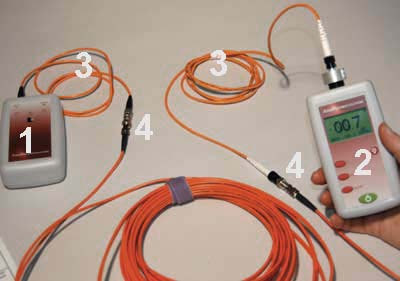Discovering the Conveniences of Optical Fiber Evaluating for Enhanced Interaction Equipments
The significance of optical fiber testing in modern communication systems can not be overstated, as it acts as a foundation for guaranteeing network integrity and efficiency. Utilizing innovative approaches such as Optical Time-Domain Reflectometry (OTDR) and insertion loss analysis, companies can not only identify faults however likewise optimize their arrangements. This positive testing strategy has extensive effects for signal quality and functional efficiency, increasing the concern of exactly how these practices add to long-term sustainability in an ever-evolving technological landscape. Comprehending these characteristics is crucial for stakeholders intending to keep an affordable edge.
Significance of Optical Fiber Screening
The significance of optical fiber screening can not be overemphasized in today's data-driven environment. As organizations progressively depend on high-speed information transmission for daily operations, the honesty and efficiency of optical fiber networks are critical. Checking guarantees that these networks can sustain the vast amounts of data generated and transferred perfectly, promoting effective interaction and connectivity.
Optical fibre testing serves multiple important functions, including confirming installation high quality, determining possible faults, and identifying total system efficiency. Normal testing can protect against costly downtimes and service disruptions, allowing companies to preserve functional connection. It assists in conformity with market requirements and regulations, ensuring that fiber optic setups meet needed specs for security and reliability.
In addition, screening can boost the long life of fibre optic systems. By proactively determining concerns such as signal loss, attenuation, or connector failures, companies can deal with issues before they rise, hence prolonging the life of their infrastructure. In recap, optical fibre screening is not merely a technical need but a strategic financial investment that improves network integrity, enhances performance, and eventually sustains the growth and effectiveness of modern interaction systems.
Key Examining Approaches

OTDR is a crucial technique utilized to identify faults, procedure splice losses, and assess the overall stability of a fiber optic web link. By sending a pulse of light down the fibre and examining the mirrored light, technicians can determine locations of faults and assess the network's efficiency over cross countries.
Insertion loss screening gauges the amount of signal loss that occurs when light travel through a connection or splice. This approach is important for validating that links meet specified loss limits, which is crucial for maintaining optimal performance in interaction systems.
Optical return loss testing quantifies the amount of light showed back in the direction of the resource because of flaws in the fiber or links. High return loss worths indicate better performance and minimized signal destruction.
With each other, these testing methods offer a detailed evaluation of fiber optic networks, ensuring their integrity and performance in diverse interaction applications.
Effect On System Efficiency
Effective optical fibre testing straight affects the total efficiency of interaction systems. By making Click Here sure the honesty of fibre optic cables, testing determines possible mistakes such as depletion, splice loss, and adapter imbalance. These problems can dramatically weaken signal high quality, leading to interruptions and lowered data transmission speeds.

Additionally, normal optical fiber screening contributes to lasting system sustainability. It makes it possible for very early detection of deterioration, enabling prompt maintenance and upgrades before major failures take place. This not just extends the life-span of the infrastructure however additionally makes sure that interaction systems stay competitive in terms of performance.
Cost-Effectiveness and Effectiveness
Cost-effectiveness is a critical factor to consider in the implementation and upkeep of optical fibre networks. Applying robust optical fibre testing procedures can significantly minimize functional expenses by identifying issues prior to they escalate into major issues. optical fibre diameter analyser. By discovering faults, depletion, and various other efficiency hindrances early, companies can stay clear of costly repairs and downtime, which can disrupt services and cause income loss
Furthermore, efficient screening methods enhance the installation procedure, enabling specialists to function better. This translates to decrease labour costs and faster job completion times. Advanced testing tools, such as Optical Time Domain Name Reflectometers (OTDRs), enables a specific analysis of fibre quality, making certain that only optimal materials are used, therefore reducing waste.
Normal testing likewise contributes to far better source appropriation. By comprehending the network's performance, companies can make educated choices regarding upgrades and expansions, making certain that financial investments are made where they are most required. In recap, optical fibre testing enhances cost-effectiveness and efficiency, supporting the long-lasting sustainability and competitiveness of communication systems in a progressively demanding market.
Guaranteeing Long-Term Dependability
Implementing extensive optical fiber testing not only improves price savings and operational performance but likewise plays an essential duty in ensuring the long-lasting dependability of interaction networks. Constant testing techniques, including depletion and data transfer analyses, help determine possible destruction in fiber performance prior to it brings look at here now about service disturbances.
By using innovative screening techniques, network operators can pinpoint mistakes or weaknesses in the fiber infrastructure, permitting prompt remediation. This aggressive strategy minimizes downtime, guaranteeing that interaction systems remain functional and efficient. Moreover, normal screening adds to the growth of a much more resistant network, as operators can adapt and maximize their facilities based upon real-time information insights. ofda.
Furthermore, making certain conformity with sector criteria via optical fiber screening strengthens the high quality go to these guys and stability of the entire communication system. This adherence not only reinforces confidence among stakeholders however likewise aligns with governing requirements, which are significantly stringent.
Final Thought
In verdict, optical fibre screening serves as a basic part in improving interaction systems. By using numerous screening approaches, such as OTDR and insertion loss evaluations, networks can attain ideal efficiency and reliability. The aggressive identification of mistakes not only boosts signal top quality however likewise lowers downtime, inevitably adding to cost-effectiveness and operational performance. Adherence to sector standards fosters stakeholder self-confidence, making sure the long-term sustainability of communication frameworks in a significantly data-driven landscape.
Comments on “A advanced optical fibre diameter analyser ensures fibre manufacturing.”